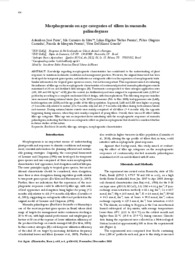Morphogenesis on age categories of tillers in marandu palisadegrass.
Morphogenesis on age categories of tillers in marandu palisadegrass.
Author(s): PAIVA, A. J.; SILVA, S. C. da; PEREIRA, L. E. T.; CAMINHA, F. O.; PEREIRA, P. de M.; GUARDA, V. D. A.
Summary: Knowledge regarding morphogenetic characteristics has contributed to the understanding of plant responses to variations in climatic conditions and management practices. However, the original framework has been developed for temperate grass species, and indicates no ontogenetic effect on the expression of morphogenetic traits. Similar information for tropical grass species is scarce, but not less important. This experiment aimed at evaluating the influence of tiller age on the morphogenetic characteristics of continuously stocked marandu palisadegrass swards maintained at 30 cm and fertilized with nitrogen (N). Treatments corresponded to three nitrogen application rates (150, 300 and 450 kg ha?¹ of N) plus the control (no fertilization) and were assigned to experimental units (1,200 m2 paddocks) according to a complete randomized block design, with four replications. The following response variables were measured during autumn/winter (Jun. to Jul. 2007) and summer (Feb. to Mar. 2008): leaf appearance rate (LAR), leaf elongation rate (LER) and the age profile of the tiller population. In general, LAR and LER were higher on young (< 2 months old) relative to mature (2 to 4 months old) and old (> 4 months old) tillers during both autumn/winter and summer. During autumn/winter swards were mainly comprised of old tillers (> 4 months old), the opposite happening during summer, when they were mainly comprised of young tillers. Overall, there was no N effect within tiller age categories. Tiller age was an important factor interfering with the morphogenetic responses of marandu palisadegrass, indicating that there is an ontogenetic effect on plant morphogenesis that should be considered further in future studies of this nature.
Publication year: 2011
Types of publication: Journal article
Observation
Some of Embrapa's publications are published as ePub files. To read them, use or download one of the following free software options to your computer or mobile device. Android: Google Play Books; IOS: iBooks; Windows and Linux: Calibre.
Access other publications
Access the Agricultural Research Database (BDPA) to consult Embrapa's full library collection and records.
Visit Embrapa Bookstore to purchase books and other publications sold by Embrapa.

